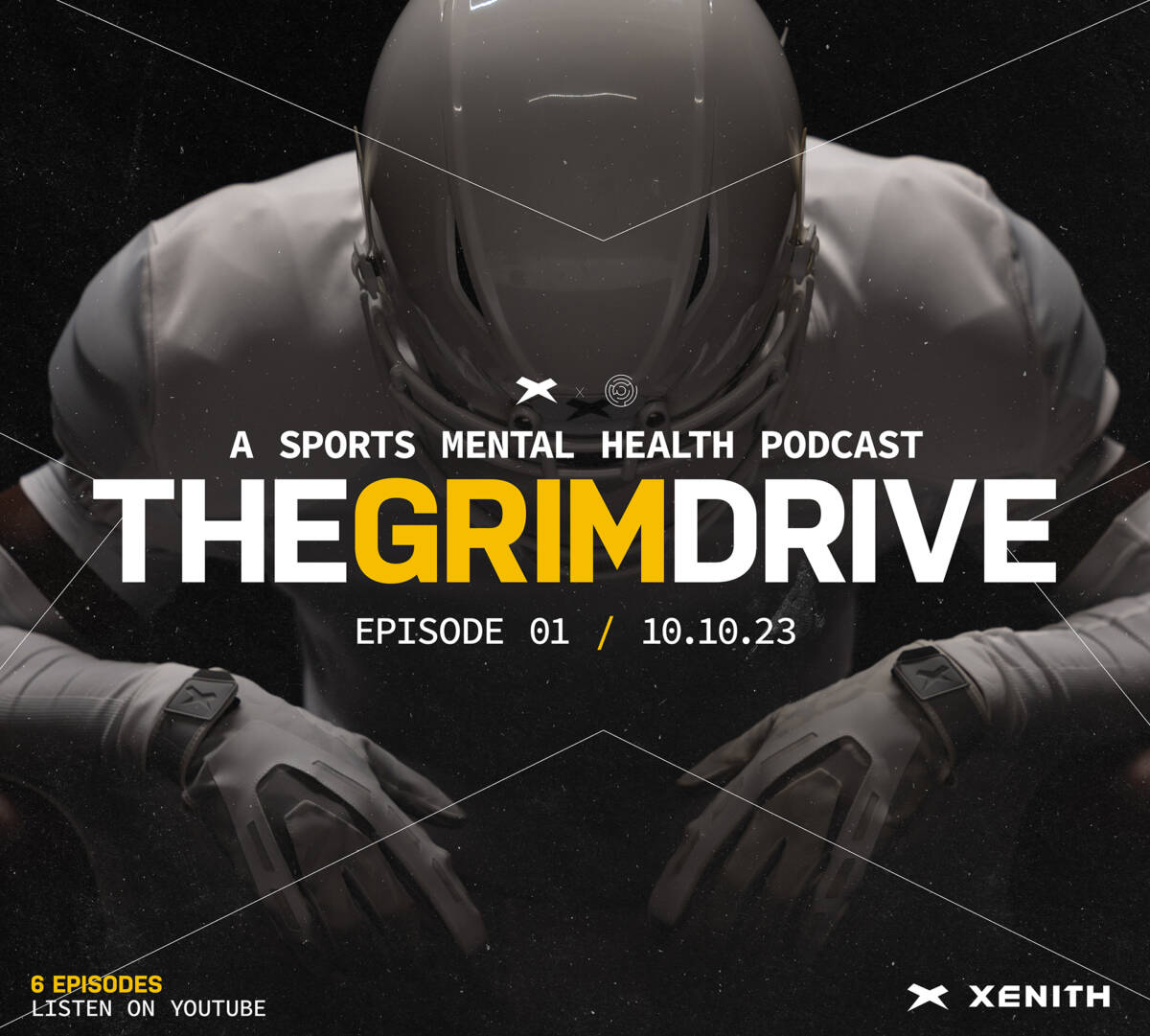
- Blog
- >
- Grim Drive: Performance Mindset
Grim Drive: Performance Mindset

October 10th, 2023
Keenan Crow
The Grim Drive Podcast is back! After taking the summer off to focus on family, the team at Riser+Tread is excited to announce our new partnership with Xenith, the industry leader in football helmet technology, to bring you a six-part podcast series covering the overlap between football, mental health, and youth sports.
Two companies that care deeply about their communities and youth sports, Xenith and Riser+Tread are aligned, crafting a podcast series with a focus on the important intersection between sports and mental health. These episodes will cover the psychological impact of injury recovery, gaining an edge through an understanding of rules and referees, considerations and conversations with the entourage, all things coaching, and purpose development for young athletes. This first episode starts at the spot that we predict will see the most growth and attention over the next decade; Performance Mindset.
Over the last 10-20 years in sports, particularly at the professional level, advanced understanding of nutrition, equipment, and physical training techniques, as well as the use of data analytics have led to improvements in overall performance. In more recent years, the athlete mindset driving the highest levels of performance has started to gain more and more attention. Performance mindset is still undoubtedly an under-utilized angle for athletes, particularly when you zoom out to consider all the nuanced areas, outside of in-game mindset, that contribute.
Barriers to the Ideal Performance Mindset
Prior to focusing on making changes in all the areas of performance mindset, it is really key to address potential barriers to change, and there are many that can occur, whether in combination or in isolation.
Moving too quickly into change mode is likely to negatively impact outcomes, as this ignores the reality that barriers to change are often standing in the way, particularly for young athletes. Here are the most common barriers we see in our work with athletes:
(watch the full podcast episode below)
Lack of interest
If an athlete, especially in youth, shows a lack of interest in a sport or in sports in general, this could very well be genuine. Sometimes that genuine lack of interest can be a reflection of their preferences and passions as a person, unlikely to change moving forward. Other times, it could be a temporary lack of interest which changes with added age or experience. This can be tricky to know for sure in the moment but is important to identify nevertheless, as there are situations where a lack of interest is adversity that could be pushed through and other times when a lack of interest needs to be respected as a reality unlikely to change.
We sometimes see a lack of interest from a young athlete as a barrier in disguise, with the real barrier being fear. Young athletes, fearful of poor performance and possible embarrassment, will display this emotion outwardly as a lack of care or interest, while this is actually a form of controlled self-sabotage. Another example of this is writing most of a school paper and then intentionally not turning it in. People will sometimes choose the worse outcome that they can have control over, in place of a better outcome that is out of their control, particularly when the outcome is not perfect and delivered at the hands of another or in front of others. Youth athletes may also sabotage performance and pretend to not care as a way to get back at a parent and/or coach for something else that took place prior. In these instances, the focus on saving face or subjectively protecting themselves is a much higher priority than the outcome of a game or their individual performance within the game.
Anxiety
While fear can show up as apathy, it is also quite common for a fear of failure to be on display in more typical ways. When an athlete is prone to hesitation or “mental mistakes” it is often due to overthinking, which is driven by fear of failure. The most extreme version of this is often referred to as “the yips”. Anxiety levels have been on the rise in our nation’s youth, even before the pandemic. Anxiety from outside of sports and performance anxiety can both contribute to a negative impact on performance if not addressed effectively.
Lack of mindset awareness
Many athletes are still unaware of the benefits of working on mindset as it relates to athletic performance. This is still an emerging concept that not all coaches are aware of, especially in youth sports where money and resources are not guaranteed to be extensive. Still, other athletes and coaches refuse to buy into the concept of a performance mindset, especially male athletes. While the stigma with mental health has been significantly reduced, particularly in the last few years, there are many who still believe that mindset, emotional intelligence, and all things mental health are “psycho-babble”, although the segment overall who reside in this camp is rapidly shrinking.
Bumpy Road Back from Injury
As we will cover in a future episode/article, the road to recovering from injury can be a huge barrier to the best mindset in sports. Whether due to an extended period of absence from participating in sports, or the lack of trust one can have in their own body or abilities due to past injury, this can be a challenging barrier to overcome, both mentally and physically.
Physical issue
There are times when an athlete has done the work on performance mindset and does everything in their control to ensure the best outcome happens on the field, ice, or court, and yet the results are not ideal. This can be due to a number of physical issues. Maybe they were playing hurt. Or maybe, what may be called out as a “mental error” or a lack of “mental toughness” is really due to a lack of physical ability. Not every athlete has been gifted with the physical abilities required to excel at the highest level, and others may just not be far along enough yet in their training.
Self-shaming
While we all want to have a short memory for mistakes, it is very normal to express disappointment when our performance at any given moment fails to live up to our intentions. It is indeed a skill to be able to move on from this quickly, but many struggle with this, which leads to mental hang-ups during games. The instantaneous and reactive self-shaming that drives this can be worked on outside of the moment, but like anything worth doing at a high level, it takes a lot of practice.
Areas of Performance Mindset
Identifying barriers and working to diminish as many as possible is a great approach to pave the way for improvement in the performance mindset. Identifying motivating factors can also help tap into a healthy approach to purpose development (which we will cover in the final episode/ article), which can drastically increase motivation and focus as well. Once an athlete is ready and willing to work on improving their mindset, there are four main areas we focus on In-game, sidelines, practice, and free time.
Covered in depth in this podcast mini-series episode by Jon Cunha, author of “The Coaching Zone: Next Level Leadership in Sports”, these areas are all important for taking a full-circle and total-person view of performance in athletics. Not only will working on these areas help improve performance, but they also contribute to athletes enjoying sports more and ultimately being more secure and stable in life overall. While most people approach performance mindset from a predominantly in-game focus, doing the hard and balanced work in these other areas will help athletes gain the ultimate edge, both in sports and in life.

